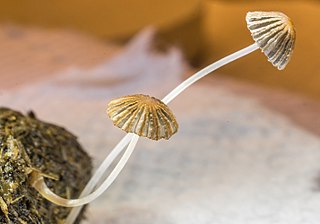
The order Sordariales is one of the most diverse taxonomic groups within the Sordariomycetes.
Tulosesus heterosetulosus is a species of mushroom producing fungus in the family Psathyrellaceae.

Podospora is a genus of fungi in the family Podosporaceae. Fossils of Podospora have been reported from 12 million year old rocks from central England.

Podospora anserina is a filamentous ascomycete fungus from the order Sordariales. It is considered a model organism for the study of molecular biology of senescence (aging), prions, sexual reproduction, and meiotic drive. It has an obligate sexual and pseudohomothallic life cycle. It is a non-pathogenic coprophilous fungus that colonizes the dung of herbivorous animals such as horses, rabbits, cows and sheep.
Zopfiella ebriosa is an unharmful fungus discovered covering the corks of wine bottles in 1991 in Tarragona, Spain. A member of the division Ascomycota, Zopfiella ebriosa is characterized by small and asymmetrical asci, presence of ostioles, and possession of germ slits.
Podospora appendiculata is a coprophilous fungus that is most commonly found in the dung of lagomorphs, such as hares and rabbits, in temperate to warm climates. A member of the division Ascomycota, P. appendiculata is characterized by ovoid, hair-studded perithecia which can bear a distinctive violaceous colouring and peridia which are coriaceous, or leathery, in texture. Podospora appendiculata has been shown to produce three compounds with antimicrobial properties.
Triangularia setosa is a member of the Ascomycota, and of the genus Triangularia. This genus is notable for its widespread appearance on the excrement of herbivores, and is therefore seen as a coprophilous fungus. The fungus itself is characteristically dark in colour and produces sac-like perithecium with a covering of hair. Its dispersion involves the ingestion, passage, and projectile ejection of spores. It has preference for colonizing the dung of lagomorphs, such as hares and rabbits.
Anopodium ampullaceum is a species of fungus first discovered by Nils Lundqvist in Sweden, in the year 1964. A. ampullaceum became one of the first few fungi along with Anopodium epile and Podospora dagonerii, to be placed in the new genus Anopodium due to their unique spores that did not suit the description of the spores of the Podospora genus, which P. dagonerii had previously belonged to. The genus Anopodium deviates from other members of the Sordariomycetes class by two spore characteristics; firstly the pedicels of its spore in the apical position, and secondly due to its immature spores having spherical bodies with cylindrical apical regions. As of 1998 all three of these species are now considered to be one species, using the name A. ampullaceum.
Lasiobolus lasioboloides is a species of coprophilous fungus in the family Ascodesmidaceae. It grows on the dung of sheep.
Lasiobolus cuniculi is a species of coprophilous fungus in the family Ascodesmidaceae. It is known to grow on the dung of sheep, goats and donkeys.
Podospora decipiens is a species of coprophilous fungus in the family Podosporaceae. It is especially common on the islands around Greece, where it grows on the dung of sheep, goats and donkeys.
Podospora macrodecipiens is a species of coprophilous fungus in the family Podosporaceae. It was discovered in Antiparos in Greece, where it was found growing on sheep dung.
Schizothecium inaequale is a species of coprophilous fungus in the family Lasiosphaeriaceae. It is known to grow in the dung of goats.
Schizothecium miniglutinans is a species of coprophilous fungus in the family Lasiosphaeriaceae. It is known to grow in the dung of goats and possibly on that of sheep.
Schizothecium tetrasporum is a species of coprophilous fungus in the family Lasiosphaeriaceae. It is known to grow in the dung of goats and rabbits.
Schizothecium vesticola is a species of coprophilous fungus in the family Lasiosphaeriaceae. In Greece, it is known to grow in the dung of goats and possibly on that of sheep, goats and donkeys. In Iceland, it has been reported from the dung of sheep, goose and horse.
Coprinopsis pseudoradiata is a species of coprophilous fungus in the family Psathyrellaceae. It grows on the dung of sheep.

Coprinopsis stercorea is a species of coprophilous fungus in the family Psathyrellaceae. It grows on the dung of sheep, goats and donkeys.
Coprinopsis vermiculifer is a species of coprophilous fungus in the family Psathyrellaceae. It is known to grow on the dung of goats.

Parasola misera is a species of coprophilous fungus in the family Psathyrellaceae. It grows on the dung of goats and possibly on that of sheep.



